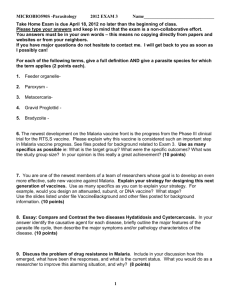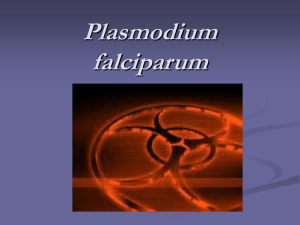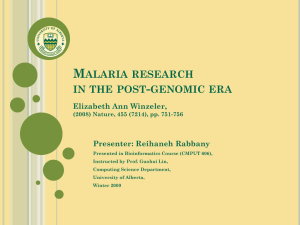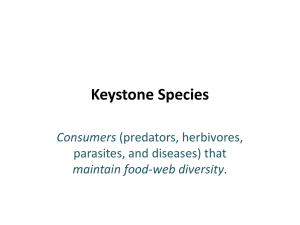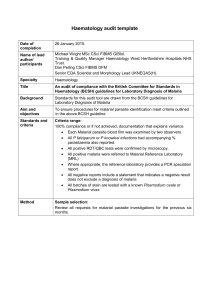Commentary Whither genome research: Of man, mosquito and malaria
advertisement
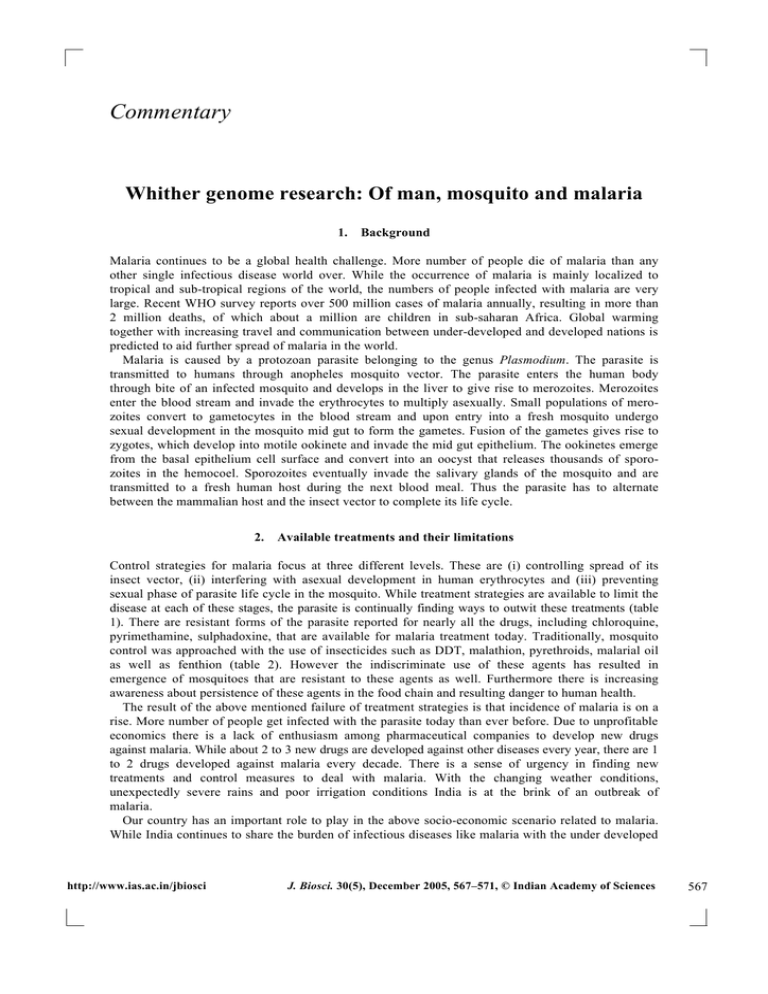
Commentary Whither genome research: Of man, mosquito and malaria 1. Background Malaria continues to be a global health challenge. More number of people die of malaria than any other single infectious disease world over. While the occurrence of malaria is mainly localized to tropical and sub-tropical regions of the world, the numbers of people infected with malaria are very large. Recent WHO survey reports over 500 million cases of malaria annually, resulting in more than 2 million deaths, of which about a million are children in sub-saharan Africa. Global warming together with increasing travel and communication between under-developed and developed nations is predicted to aid further spread of malaria in the world. Malaria is caused by a protozoan parasite belonging to the genus Plasmodium. The parasite is transmitted to humans through anopheles mosquito vector. The parasite enters the human body through bite of an infected mosquito and develops in the liver to give rise to merozoites. Merozoites enter the blood stream and invade the erythrocytes to multiply asexually. Small populations of merozoites convert to gametocytes in the blood stream and upon entry into a fresh mosquito undergo sexual development in the mosquito mid gut to form the gametes. Fusion of the gametes gives rise to zygotes, which develop into motile ookinete and invade the mid gut epithelium. The ookinetes emerge from the basal epithelium cell surface and convert into an oocyst that releases thousands of sporozoites in the hemocoel. Sporozoites eventually invade the salivary glands of the mosquito and are transmitted to a fresh human host during the next blood meal. Thus the parasite has to alternate between the mammalian host and the insect vector to complete its life cycle. 2. Available treatments and their limitations Control strategies for malaria focus at three different levels. These are (i) controlling spread of its insect vector, (ii) interfering with asexual development in human erythrocytes and (iii) preventing sexual phase of parasite life cycle in the mosquito. While treatment strategies are available to limit the disease at each of these stages, the parasite is continually finding ways to outwit these treatments (table 1). There are resistant forms of the parasite reported for nearly all the drugs, including chloroquine, pyrimethamine, sulphadoxine, that are available for malaria treatment today. Traditionally, mosquito control was approached with the use of insecticides such as DDT, malathion, pyrethroids, malarial oil as well as fenthion (table 2). However the indiscriminate use of these agents has resulted in emergence of mosquitoes that are resistant to these agents as well. Furthermore there is increasing awareness about persistence of these agents in the food chain and resulting danger to human health. The result of the above mentioned failure of treatment strategies is that incidence of malaria is on a rise. More number of people get infected with the parasite today than ever before. Due to unprofitable economics there is a lack of enthusiasm among pharmaceutical companies to develop new drugs against malaria. While about 2 to 3 new drugs are developed against other diseases every year, there are 1 to 2 drugs developed against malaria every decade. There is a sense of urgency in finding new treatments and control measures to deal with malaria. With the changing weather conditions, unexpectedly severe rains and poor irrigation conditions India is at the brink of an outbreak of malaria. Our country has an important role to play in the above socio-economic scenario related to malaria. While India continues to share the burden of infectious diseases like malaria with the under developed http://www.ias.ac.in/jbiosci J. Biosci. 30(5), December 2005, 567–571, © Indian Academy of Sciences 567 Commentary 568 nations, it is on a road to fast economic growth. The country is witnessing growth of a mature pharmaceutical industry and it does have the scientific and economic might to wage an attack on malaria. Indeed there is an opportunity for India to make a contribution to science as well as mankind in general, by supporting research directed at control of malaria. 3. Malaria control in the post-genomic era Genome sequences of the three-component disease system of malaria are available today. Genomes of the vertebrate host Homo sapiens, the invertebrate vector Anopheles gambiae as well as the parasite Plasmodium falciparum have been fully sequenced. Genome sequence of the related human parasite Plasmodium vivax is also nearing completion. The publications of genome sequences have opened new avenues to find mechanisms to interfere with the spread of malaria. Publication of the genome sequence of the Anopheles vector has made it possible to identify mosquito genes that may be necessary for parasite sexual development in the Anopheline vector. A recent elegant study by Eappen et al (2005) focused on mosquito genes that are induced in response to parasite development in the mosquito mid gut. They identified a serine protease inhibitor gene (SRPN6) that is strongly induced in P. berghei infected Anopheles. The group further showed that inhibiting the expression of SRPN6 or its knock out in A. gambiae could delay release of sporozoites in the salivary glands of the vector and Table 1. Antimalarial compounds and their targets. Pathway or mechanism Target location Cytosol Food vacuole Existing therapies Dihydrofolate Pyrimethaminer, Chorproguanil reductase proguanil Dihydropteroate Sulfadoxiner , synthase dapsone 5-fluoroorotate Thymidylate synthase Glycolysis Lactate dehydrogenase Gossypol derivatives Purine salvage pathway PfAdSS Hadacidin Cytosolic chaperone PfHsp90 Geldanamycin PfATP6 Phospholipid synthesis Choline transporter Membrane transport Unique channels Heme polymerization Hemozoin Haemoglobin hydrolysis Plasmepsins Quinolies Falcipains Free radical generation Unknown Mitochondrion Apicoplast r New compounds Folate metabolism Parasite endoplasmic Orthologue of mamreticulum malian SERCA Parasite membrane Target molecule Artemisinins References (new agents) Nzila et al 2000 Rathod et al 1992 Eaazhisai et al 2004 Banumathy et al 2003; Pavithra et al 2004 Curcumin Reddy et al 2005 G25 Dinucleoside dimers Gero et al 2003 New quinolines Protease inhibitors Protease inhibitors New peroxides De et al 1998 Francis et al 1994 Rosenthal 2001 Electron transport Heme biosynthesis Cyt. c oxidoreductase Atovaquoner PfALAS Ethanolamine Varadharajan et al 2002 Protein synthesis DNA synthesis Transcription Type II fatty acid biosynthesis Apicoplast ribosome Antibiotics DNA gyrase Quinolones RNA polymerase Rifampin FabH Thiolactomycin Waller et al 1998 Mutations in Plasmodium falciparum associated with resistance. J. Biosci. 30(5), December 2005 Commentary 569 thereby stop the spread of the parasite to humans. A number of such reports exist in the literature about mosquito genes that help themselves in defending against parasite infection. In addition to increasing our understanding about parasite development in the mosquito such research may provide new tools to control the disease in future. Based on these strategies it appears possible to create malaria – blocking transgenic mosquitoes. Also, volatile compounds present in humans sweat are known to attract mosquitoes for blood meal. Genes coding for odourant receptors responding to these compounds have been identified in the mosquito genome. It may be possible to design aerosol sprays that can manipulate mosquito responses and thereby diverting them away from humans. Another level at which Anopheles genome sequence can help in malaria control is by identification of genes responsible for insecticide resistance. This knowledge may help in monitoring and over-riding insecticide resistance in the vector. Identification of genes unique to the malarial parasite, not present in the human host, has become possible through analysis of the parasite genome. Analysis of the 35 kb genome from the apicoplast of the parasite has resulted in identification of several genes that are unique to the parasite and hence are potential targets for intervention. In addition to identification of new drug targets, analysing targets of existing drugs is also aided by the availability of parasite genome sequence. In a recent study Geldanamycin, which is a specific inhibitor of Hsp90, was shown to be effective in inhibiting parasite growth in human erythrocytes (Banumathy et al 2003). Availability of the parasite genome sequence facilitated identification and characterization of the target Hsp90 homolog from the parasite. Availability of transcriptome and proteome data of parasite genes during asexual and sexual development of the parasite also offers new possibilities to control the development of the parasite in humans or in mosquitoes. In addition to aiding identification of receptors for malaria on hepatocytes and red blood cells, human genome sequence may also help identification of genes involved in resistance to malaria infection. Understanding genetic loci involved in host response to infection by the malarial parasite is also becoming an important area of research. Despite availability of parasite genome sequence, the progress in identification of new drug targets has been slow. There are limited number of new claims for potential drug targets against the parasite, which include enzymes of the heme biosynthesis pathway (Varadharajan et al 2002), enzymes of the fatty acid biosynthesis pathway (Surolia and Surolia 2001) and heat shock protein 90 (PfHsp90) of the parasite. Artemisinin is the only new drug that has entered the market in the last few years. While the compound is indisputably effective in controlling malaria, there is controversy about its mode of action. 4. Impact of malaria genome sequence The promise of novel drug targets and new strategies of interventions against malaria seem real in the post-genomic era. To get a measure of the impact of Plasmodium genome sequence on the progress of malaria research we examined all the publications on malaria research in the time window of 3 years before and after the publication of the genome sequence. We classified these publications into dif- Table 2. Vector control methods. Source reduction a. Chemical larvicides: Themiphos, Fenthion; b. Application of oils to the water surface; c. Biological larvicides: Guppy and Gambusia fish Bacteria: Bacillus sphaericus, Bacillus thuringiensis var israelensis; Fungi: Lavegeridium giganteum Mermitid nematodes: Romanomermis culicivorax. d. Insect growth regulators: Methroprene. Indoor residual spraying DDT and dieldrin. Adult mosquito control a. Preventing adult mosquito entry into human dwellings; b. Personal protection measues; c. Adult insecticide sprays: Space sprays, Melathion, Fenitrothion, Pirimiphos methyl, Deltamethrin, Lamda cyhalothin, Insecticide vaporizers. Other vector control methods a. Personal protection methods: Window screens, insecticide treated nets, repellents; b. Sterile male vector release; c. Genetic modification of malaria vectors. J. Biosci. 30(5), December 2005 Commentary 570 Figure 1. Literature curation on malaria before and after the publication of genome sequence. ferent categories based on their significance. From about 12,000 publications that were examined, we filtered out those related to epidemiological studies and classified the rest into (i) significant publications (published in Nature, Science or Cell), (ii) work on genes, PCR, transcription, translation, cloning, expressed proteins, enzymatic activity, trafficking etc. Were classified as protein study, gene study or protein and gene study and (iii) work on pharmacology, therapeutics, metabolic pathways, life cycle, growth, metabolism, vaccine development etc were classified as drug, vaccine or biology related study. The results of this analysis are shown in the form of a bar diagram in figure 1. Interestingly enough, the analysis indicates a downward trend in the quality of research on malaria in the post-genomic era. While there is an upward trend in the number of publications related to protein study, all the other categories showed a decline in number. The analysis presents a bleak picture about the trend of scientific research in the post genomic era. Notwithstanding, there is little doubt that genome research has made the process of scientific inquiry more accurate. Besides its influence on strategies to control malaria, genome sequence has helped researchers understand the basic biology of the parasite. It is easier to make new predictions and test them in the framework of genome information. Analysis of parasite metabolic pathways, mechanisms of protein transport, stage specific proteome expression as well as protein-protein interactions have all been possible because of the genome sequence information. At the same time, a significant part of the parasite genome sequence remains un-interpretable and reveals some surprises about parasite biology. A large number of parasite genes (about 60%) fail to show obvious sequence similarity to any known genes. Genes coding for some important functional categories, like transcription factors, have not been identified yet. These present an important challenge to the scientific community. Regardless of the actual outcome of the genome research in terms of drug and vaccine development, malaria researchers are in for an exciting time ahead. Acknowledgements The authors would like to thank Ms Sri Rama, Mr Chandan, Mr Anand Ram and Mr Santosh, students of the Bangalore University for their participation in malaria literature curation and data analysis. Due to space constraint several important publications could not be cited in this article. J. Biosci. 30(5), December 2005 Commentary 571 References Abraham E G, Pinto S B, Ghosh A, Vanlandingham D L, Budd A, Higgs S, Kafatos F C, Jacobs-Lorena M and Michel K 2005 An immune-responsive serpin, SRPN6, mediates mosquito defense against malaria parasites; Proc. Natl. Acad. Sci. USA 102 16327–16322 Banumathy G, Singh V, Pavithra S R and Tatu U 2003 Heat shock protein 90 function is essential for Plasmodium falciparum growth in human erythrocytes; J. Biol. Chem. 16 278 18336–18345 De D, Krogstad F M, Byers L D and Krogstad D J 1998 Structure-activity relationships for antiplasmodial activity among 7-substituted 4-aminoquinolines; Med. Chem. 41 4918–4926 Eaazhisai K, Jayalakshmi R, Gayathri P, Anand R P, Sumathy K, Balaram H and Murthy M R N 2004 Crystal Structure of Fully Ligated Adenylosuccinate Synthetase from Plasmodium falciparum; J. Mol. Biol. 335 1251– 1264 Francis S E, Gluzman I Y, Oksman A, Knickerbocker A, Mueller R, Bryant M L, Sherman D R, Russell D G and Goldberg D E 1994 Molecular characterization and inhibition of a Plasmodium falciparum aspartic hemoglobinase; EMBO J. 13 306–317 Gero A M, Dunn, Brown C G, Pulenthiran M, Gorovits M, Bakos L and Weis A L 2003 New malaria chemotherapy developed by utilization of a unique parasite transport system; Curr. Pharm. Des. 9 867–877 Nzila A M, Nduati E, Mberu E K, Hopkins Sibley C, Monks S A, Winstanley P A and Watkins W M 2000 Molecular evidence of greater selective pressure for drug resistance exerted by the long-acting antifolate Pyrimethamine/Sulfadoxine compared with the shorter-acting chlorproguanil/dapsone on Kenyan Plasmodium falciparum; J. Infect. Dis. 181 2023–2028 Pavithra S R, Banumathy G, Joy O, Singh V and Tatu U 2004 Recurrent fever promotes Plasmodium falciparum development in human erythrocytes; J. Biol. Chem. 279 46692–46699 Rathod P K, Leffers N P and Young R D 1992 Molecular targets of 5-fluoroorotate in the human malaria parasite, Plasmodium falciparum; Antimicrob. Agents Chemother. 36 704–711 Reddy R C, Vatsala P G, Keshamouni V G, Padmanaban G and Rangarajan P N 2005 Curcumin for malaria therapy; Biochem. Biophys. Res. Commun. 326 472–474 Rosenthal P J 2001 Protease inhibitors. Antimalarial Chemotherapy: Mechanisms of Action, Resistance, and New Directions in Drug Discovery (Totawa, NJ Humana Press) pp 325–345 Surolia N and Surolia A 2001 Triclosan offers protection against blood stages of malaria by inhibiting enoylACP reductase of Plasmodium falciparum; Nat. Med. 7 167–173 Varadharajan S, Dhanasekaran S, Rangarajan P N and Padmanaban G 2002 Involvement of d-aminolevulinate synthase in de novo heme synthesis by Plasmodium falciparum; Biochem. J. 367 321–327 Waller R F, Keeling P J, Donald R G, Striepen B, Handman E, Lang-Unnasch, Cowman A F, Besra G S, Roos D and McFadden G I 1998 Nuclear-encoded proteins target to the plastid in Toxoplasma gondii and Plasmodium falciparum; Proc. Natl. Acad. Sci. USA 95 12352–12357 UTPAL TATU* SAMTA JAIN P PADMA PRIYA Department of Biochemistry, Indian Institute of Science, Bangalore 560 012, India *(Email: tatu@biochem.iisc.ernet.in) ePublication: 25 November 2005 J. Biosci. 30(5), December 2005
